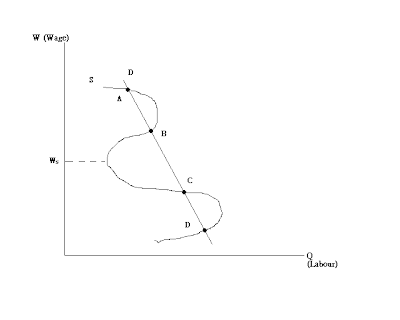Prasch 的 How Markets Work 的方向是講出一般市場的條件(私有產權、合約法等),然後說一個商品市場是如何運作,有什麼假設,接著再跟其他市場比較。不難估到,最後是想顯示市場是多樣的,不同的市場有不同的運作方法,應套商品市場那套會有不良影響。
先說(或者係只說)其中一章--勞動市場。與商品市場的最大的差異是供應曲線 (supply curve),是一個反C 加上一個S。人到非常有錢的時候,便減少勞動。但當人還未或者不是非常有錢,人會隨著人工的上升而工作長一點時間。以上是可生存工資(Subsistence Wage, Ws)以上的情況。
當工資開始從可生存工資開始下滑後,人亦會工作長一點,為了可以賺夠生活。但是工資低到一個地步是再多的工時也是得不償失。人一天只有24小時,工作左了20小時還會健康嗎? 這時候你會再次減低工作時間,反正都一樣。
這樣的供應曲線與需求曲線會有四個交叉點。但只有兩個是穩定的平衡點(B 及 D)。而多個平衡點則帶出以下反傳統的結果:
".... it features two locally stable equilibrium points.. These reflect high wages/low hours and low wages.high hours respectively... Under "free market" conditions the system has a built-in tendency to gravitate to one of these two points and remain there. The particular equilibrium that is eventually achieved is entirely dependent upon initial conditions in the market. This is a critical finding. If this theory is a plausible representation of the low wage labour market it follows that no amount of education, training, exhortation or lectures on moral uplift directed at the poor will force the labour market equilibrium to move from point D to point B. Once achieving a poverty trap, the system remains there. End of story." (p. 92)
最重要的是由於多過一個平衡點,市場上出現的低工資就是唯一的有效率的平衡點便不成立:
"Given the existence of two locally sable equilibrium points, there is no a priori reason to believe that equilibrium at point D is more "natural", "efficient", or likely to occur than that at point B. Moreover, the wage level at point D can no longer be presumed to uniquely represent the "true market value" or "marginal product" of labour. The reason is that the lower wage/higher hours equilibrium at point D is every bit as consistent with the operations of a free market as the higher wage/lower hours equilibrium featured at point B. Again, let us recall that both equilibria are locally stable which means that once they are achieved, the market embodies no internal mechanism or competitive force that will induce a change in the result." (p. 92)
而作者亦提到,最高工時與這種經修改的供應曲線如何產生相互作用:
"A more interesting and significant lesson follows from the co-existence of two equilibria. These have direct implications for the efficacy of minimum wage or maximum hours laws. Consider, once more, Figure V.3. Suppose a maximum hours law were to be imposed that was just below the hours that would otherwise be contributed at point C. In light of the market dynamics illustrated by the arrows on the figure, it is evident that such a restriction would set processes in motion that would continue until the equilibrium at point B is acheived. Interestinly, the initial hours limitation would not be "binding" in the sense that the equilibrium hours worked once all adjustments had occurred would be less than the mandated maximum - a nice illustration of how market forces can interact with legislation to bring about results that are not immediate evidence or expected." (p. 93)
".... it features two locally stable equilibrium points.. These reflect high wages/low hours and low wages.high hours respectively... Under "free market" conditions the system has a built-in tendency to gravitate to one of these two points and remain there. The particular equilibrium that is eventually achieved is entirely dependent upon initial conditions in the market. This is a critical finding. If this theory is a plausible representation of the low wage labour market it follows that no amount of education, training, exhortation or lectures on moral uplift directed at the poor will force the labour market equilibrium to move from point D to point B. Once achieving a poverty trap, the system remains there. End of story." (p. 92)
最重要的是由於多過一個平衡點,市場上出現的低工資就是唯一的有效率的平衡點便不成立:
"Given the existence of two locally sable equilibrium points, there is no a priori reason to believe that equilibrium at point D is more "natural", "efficient", or likely to occur than that at point B. Moreover, the wage level at point D can no longer be presumed to uniquely represent the "true market value" or "marginal product" of labour. The reason is that the lower wage/higher hours equilibrium at point D is every bit as consistent with the operations of a free market as the higher wage/lower hours equilibrium featured at point B. Again, let us recall that both equilibria are locally stable which means that once they are achieved, the market embodies no internal mechanism or competitive force that will induce a change in the result." (p. 92)
而作者亦提到,最高工時與這種經修改的供應曲線如何產生相互作用:
"A more interesting and significant lesson follows from the co-existence of two equilibria. These have direct implications for the efficacy of minimum wage or maximum hours laws. Consider, once more, Figure V.3. Suppose a maximum hours law were to be imposed that was just below the hours that would otherwise be contributed at point C. In light of the market dynamics illustrated by the arrows on the figure, it is evident that such a restriction would set processes in motion that would continue until the equilibrium at point B is acheived. Interestinly, the initial hours limitation would not be "binding" in the sense that the equilibrium hours worked once all adjustments had occurred would be less than the mandated maximum - a nice illustration of how market forces can interact with legislation to bring about results that are not immediate evidence or expected." (p. 93)
(總算叫填返條數。)

This comment has been removed by the author.
ReplyDelete(沒看過此書) 有兩點想問問︰
ReplyDelete1. 為甚麼A與C不是平衡點?前提是「大體而言每個人都想工作多一點」?
2. 為甚麼解釋勞工市場一定是勞動力是supply,勞動需求是demand?反過來說,工作是supply,想要工作的人是demand又怎樣?
又︰支持閱讀報告系列
(不知最後會出甚麼名字,我是T)
1. 書中有提及。我們先考慮A 點,將A點的工資叫做Wa。如果工資僅僅高過Wa 時,資方需要出多很多錢來引誘勞方提供資方想要的勞動量。如果工資僅僅低過Wa 時,市場上的供應量大過,甚至遠大過需求量,激烈競爭下會使價格下降。
Delete2. 需求的定義是價格上升,市場上的總需求量會上升。供應是價格上升,供應量上升。但誠如你所見,上文中提到的供應曲線有時候是與需求是同一方向的,所以供應曲線的定義已經不再「正確」了,這亦代表有時候像需求,越貴我越不要,有時候像供應,越貴我越要供應。
此處有許許多多的假設,其實有想過會不會有實證一點的數據/圖表是從現實得來的。